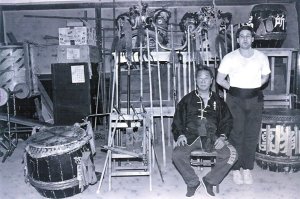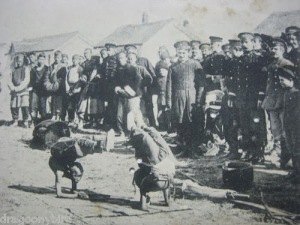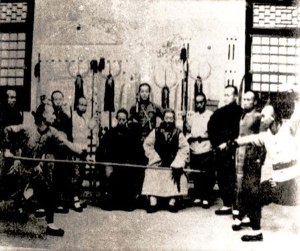This is a rough cut of the introduction to the new book…..

I began studying Chinese martial arts at a relatively young age, and like every one of my generation I was quickly inundated with stories about Shaolin Buddhist monks, Wudang Daoist priests and semi-magical powers such as the “armor of the golden bell.” During this period, we had countless kung-fu movies about the creation of the Hong Jia / Hung Ga (洪家) system, about how the priest “White Eyebrow” (白眉) killed Zhi Shan (至善), and about how the “tiger and crane” (虎鶴雙形) set was created. There were also, and still are today, people who told us Chinese martial arts originated from Chinese religious practices, that it was a spiritual pursuit and that martial artists were righteous men who cultivated “martial virtue” (武德). Adding to the confusions for most western students were the differences between the various Chinese dialects (Mandarin, Cantonese, Fujianese, etc.) and the often haphazard methods of transliteration.
At first, especially as a young boy, I was enthralled by all these stories. However, the more I trained and spent time in the tradition, and the more I really thought about them, the more they did not quite seem to add up. In fact, they frequently seemed to contradict each other. Martial arts were the product of Buddhist and Daoist religious practices, developed by monks and priests to cultivate virtue? Yet all our kung-fu movies were about fighting, about revenge, featuring secret societies and often bandits and criminals who engaged in drunken brawls, often, upon closer inspection, in brothels! If you were training with Chinese teachers in Chinese communities, you were undoubtedly surrounded by gambling and Chinese organized crime. During Chinese New Year the students would go out lion dancing with weapons, because the lions of two different schools might cross each other and a fight could break out. Depending upon who your teacher was and where you trained, you might have been exposed to even more contradictory experiences.

I attended the Elliott School of International Affairs at George Washington University in pursuit of a graduate degree in Chinese history. Rigorous academic training and reading the works of the best historians and political scientists in the field confirmed my long held suspicions that much of what is taught as Chinese martial arts history is not only contradictory, it is mostly improbable and at times outright impossible. At the same time, I began to appreciate the underlying reasons why much of this mythology was created and why it persisted. Modern Chinese history is complex and remains controversial, its interpretations still subject to very real political agendas. Nor are the many issues that shaped and changed modern China easily compartmentalized. For a diversity of reasons, the martial artist was swept up into virtually all of these events, and forever changed by them.

Chinese martial arts history must by its nature be a multi-disciplinary approach. It must embrace military, political, social and even religious history. It certainly requires study of the lower classes and the marginalized, but it was also shaped to great degrees by the educated and the elite and their agendas as well. It is, in my opinion, best understood as a multilateral relationship. That the average martial arts student has trouble placing their practices into the proper historical context is really no surprise. Well trained, intelligent historians and political scientists have disagreed upon many interpretations; they confused the “New Culture Movement” and the “May 4th Movement”, took “Triad” (Heaven and Earth Society) propaganda as history, and mistook the origins of the Boxer Uprising as just a few examples. Of course, in martial arts, the student also often has a “guru” relationship with their teacher and does not want to investigate, much less challenge, the word of their teacher.

In my opinion, within the context of Chinese society, the martial artist has always been a source of concern for two interrelated reasons. First, fundamentally martial arts are the skills of violence and Chinese society has always had ambivalence towards violence. In China, martial artists were thought of as both legendary heroes and yet also as members of the least desirable classes. Joseph Esherick stressed that martial arts in and of itself was politically neutral. It was used as much by the imperial military, gentry and village militia, and the forces of law and order as it was used by criminals, bandits and rebels. But in a society which divided the Civil (文) and the Military (武), and subordinated the latter to the former, there were tensions even in its legitimate applications.

The second concern was the nature of the subculture the martial artist inhabited. Chinese society strived for vertical hierarchies; in the family the grandfather to the father to the son, in the village the lineage leaders to the middle peasant to the poor peasant, in the political arena the imperial capital to the provincial government to the local official who interacted with the local gentry elite. Martial artists legitimate or not, were frequently itinerant. Their lifestyles made them part of the so-called “Jiang Hu” (江湖) subculture. They identified with each other, as martial artists, in horizontal associations which crossed lineages, villages, provinces and frequently even ethnicities.
Obviously, martial artists only really presented a problem for society when they chose to use their skills in violence in illegal, disruptive ways. But when they did, the nature of their subculture presented a particular problem. As Philip Kuhn has noted, the institutions that had been put in place against the illegal and disruptive, such as the Baojia (保甲), had been intended for vertical hierarchies in settled populations. They were virtually useless with itinerant populations such as martial artists.
This structural problem had existed since the Song Dynasty, when both the Baojia system and the independent martial arts teacher had emerged. In the Qing period, the real change was one of perception. The martial artist was perceived increasingly as connected to religious sectarian rebellions in the north, secret society rebellions in the south, the Taiping civil war and finally with the Boxer Uprising. We will discuss how the final and most damaging of these events to the reputation of the martial artist, the Boxer Uprising, may not have even had a direct relationship to mainstream martial arts practice but the damage was done none the less.

In the Republic period, the already much maligned and discredited martial arts also suffered criticism as another feature of China’s “feudal past.” It appeared on the verge of extinction, if not for two new, but contradictory impulses. While most progressives dismissed martial arts as the superstitious nonsense of uneducated peasants, a small segment saw the potential to reform it as a form of physical education to serve the nation. Of course, these reformers sought not only to remove the superstitious and the ignorant from the practice of martial arts, they also sought to remove its associations with actual fighting!

On the other end of the spectrum, nationalists saw in martial arts the opportunity to throw off the yoke of the “sick man of Asia” and revitalize the nation militarily. Nationalistic generals organized events to actively seek those who had skill in fighting, to teach a new generation military skills. Along the way, the nationalists were also willing to embrace a little superstition; nationalistic pride encouraged the idea that Chinese martial was not simply another form of physical education like western gymnastics. It was a distinctly Chinese skill, and only from Chinese martial arts could you develop unique fighting skills such as the use of qi (氣).
The martial artists themselves were struggling to regain what little social acceptance they had acquired in the Ming and Qing periods. They appeared to be willing to embrace both the progressive and nationalist movements. It was a syncretic but not always internally logical approach that leaves us with many of the contradictions we confront in our modern practice.

As a graduate student, I encountered research that, while not directly focused on Chinese martial arts, was relevant to its understanding. Of course, the challenge in both history and political science has always been producing something that the general public can easily access and enjoy. Even Joseph Esherick’s volume on the Boxer Uprising, filled with important information on the evolution and practice of martial arts, is not an easy read for the non-historian. Recently, I have seen studies that not only explicitly address the history of Chinese martial arts, but are aimed at the general reader. I hope my volume serves as a useful addition.
My volume serves as an outline of Chinese martial arts history. It is an outline because it attempts to present all the various issues and events of importance but in no way attempts to address them completely. In many cases, I have indeed made some generalizations. Each issue or event discussed here would be worthy of, and in most cases already is, a separate volume. In many cases, it has been addressed by numerous volumes. Please refer to the bibliography at the end of this book.
I tend to conceive of this as a modern Chinese martial arts history. We begin with a brief discussion of the origins of these methods, gather a little more momentum with the Ming period, but most of the attention is upon the Qing and Republican periods. In summary; the Ming period gave birth to martial arts as we understand them (unarmed methods with distinct names), the Qing period saw challenges to their existence that required response, and the Republican period was the time in which those responses reshaped the culture and created contradictions we must now contend with.

Leave a comment